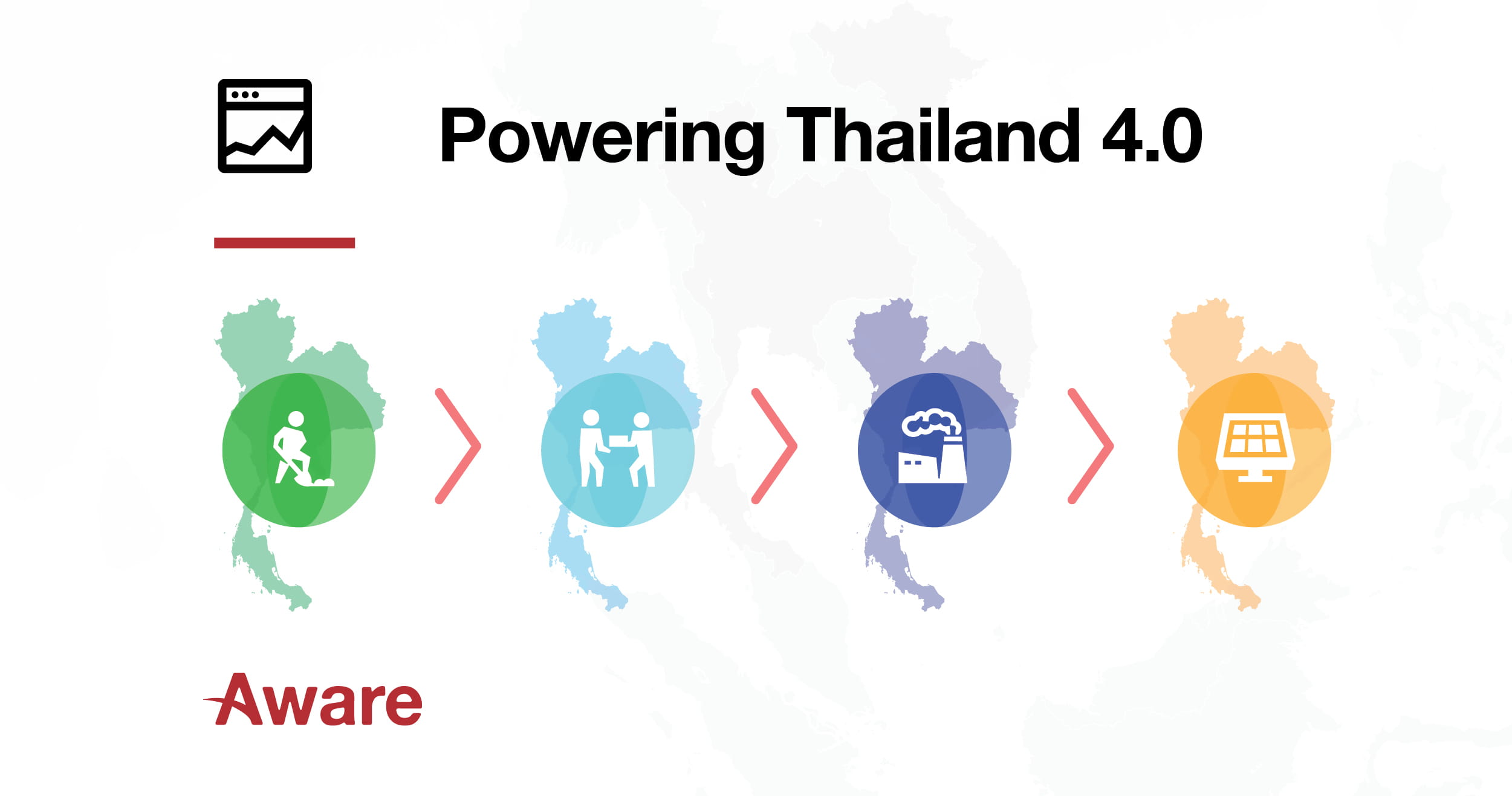
22 Oct Powering Thailand 4.0

The move towards Thailand 4.0 is something that is close to Aware’s heart – the rise of technology, innovation and smart business in Thailand. We know the small part we can play in helping make this happen. If you would like to discuss how your business can work smarter or integrate digital transformation, you can send us an email or give us a call.
What is Thailand 4.0?
Thailand 4.0 is a sector-specific vision to transform the Thai economy, pulling it out of the middle-income trap and developing it into an innovative, dynamic, high-income country.
To make this change happen policy is being laid out that will move the Kingdom’s economy from one that is reliant on manufacturing existing products into one that is pioneering products of their own through research, development, and invention.
This is framed under the moniker “Thailand 4.0”. You can view our detailed infographic here.
The Thailand .0s:
Thailand has undergone 3 economic and industry leaps, to get where it is today:
Thailand 1.0 was about agriculture: during this stage, Thais made a living on farmlands and livestock, growing rice and raising chickens – for the most part, they could live off the land and any small money was reinvested back into the crop.
Thailand 2.0: was the rise of light manufacture: clothes, bags, beverages, stationery, ornaments and with this Thailand’s overall potential soared as a place for small-scale manufacturing and became a go-to location internationally.
Thailand 3.0 Is where we are at present, the manufacturing of heavy goods like steel, automobiles, and gases. However, they are still reliant on foreign technologies in manufacturing goods. The initial stages of Thailand 3.0 were very promising but not sustainable and while showing promising growth at the beginning recently this has stagnated.
We want to move to 4.0, but how is this done?
Change in the types of businesses and services Thailand provides: today Thailand’s largest exports include textiles and rice – which would be regarded as “high effort low output” commodities – Thailand is hoping to dynamically change how these exports are made OR cease producing them. Thailand is the “rice-bowl of Asia” – it may not want to decrease production but implement “smart-agriculture” methodology.
The higher value exports like cars and computers are on the whole for companies that are not Thai controlled or they are buying technology to manufacture them. This is the essence of Thailand 4.0. Thailand and its evolution towards innovating products will be critical.
Labor skills and the employee market needs to be changed, lower-skilled employees will be encouraged to retrial and become skilled and highly educated. Focus needs to be spent on educating people to learn the high-technology skills of the modern world.
The issues:
Middle Income Gap: The middle-income trap is a situation where a country’s growth slows after reaching middle-income levels. Middle-income countries like Thailand are squeezed between their low-wage competitors that dominate the labor opportunities and the rich countries that are actually innovating the products.
Digital Transformation: AI, big data and the internet of things are increasingly being used in production and management processes, especially for large enterprise businesses. These technologies will be leveraged to increase efficiency and will begin to weed out low-paying, low-skill jobs: a 21st-century economy cannot be built with a low-skilled 20th-century workforce.
There are 4 clear objectives of Thailand 4.0:
1. Economic prosperity: to create a value-based economy that is driven by innovation, technology, and creativity – the mode aims to increase Research and Development to around 4%, which trigger an economic growth rate of 6% within 5 years. The goal is to increase income per capita from $5,500 in 2014 to $15,000 by 2032.
2. Social Well-being: To create a society that moves forward without leaving anyone behind. The goals are to reduce social disparity from 0.465 in 2013 to 0.36 in 2032. In the hope of transforming the social welfare system by turning traditional farmers into smart farmers, traditional SMEs to startups and going from low-value services to high-value services.
3. Raising Human Values: Pushing Thailand into the top 50 HDI within 20 years and have at least 5 Thai universities ranked amongst the world’s top 100 within 20 years.
4. Environmental Protection: to do all this and achieve “sustainable growth and development” without damaging the environment. Thailand aspires to have 10 cities among the most livable cities in the world, which will require substantial infrastructure investment.
- Microsoft Copilot vs ChatGPT: Navigating the Future of AI Assistants - April 3, 2024
- Harnessing Microsoft 365 Copilot for Educational Excellence - March 21, 2024
- How Can Microsoft Copilot Help Human Resources Staff? - March 20, 2024
- Microsoft Copilot for Human Resources - March 20, 2024
- The Business Benefits of Microsoft Copilot for Marketing Professionals - February 19, 2024
- The key business benefits of Microsoft Copilot - February 19, 2024
- How To Increase Your Employee’s Productivity with Copilot for Microsoft 365 Word - February 16, 2024
- Transform with AI – Journey with Aware - November 20, 2023
- What is Edge Computing? Advantages and Disadvantages: - May 20, 2022
- SAP Business One Vs Microsoft Dynamics 365 - November 12, 2021

